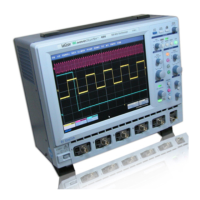154 WM-OM-E Rev I
pks Peaks
Definition:
The number of peaks in a histogram.
Description:
The instrument analyzes histogram data to identify peaks from background noise
and histogram binning artifacts such as small gaps.
Peak identification is a 3-step process:
1. The mean height of the histogram is calculated for all populated bins. A
threshold (T1) is calculated from this mean, where:
T1= mean + 2 sqrt (mean).
2. A second threshold is determined based on all populated bins under T1 in
height, where:
T2 = mean + 2 * sigma,
and where sigma is the standard deviation of all populated bins under T1.
3. Once T2 is defined, the histogram distribution is scanned from left to right. Any
bin that crosses above T2 signifies the existence of a peak. Scanning continues
to the right until one bin or more crosses below T2. However, if the bins cross
below T2 for less than a hundredth of the histogram range, they are ignored,
and scanning continues in search of peaks that cross under T2 for more than a
hundredth of the histogram range. Scanning goes on over the remainder of the
range to identify additional peaks. Additional peaks within a fiftieth of the range
of the populated part of a bin from a previous peak are ignored.
NOTE: If the number of bins is set too high, a histogram may have many small gaps. This increases
sigma and, thereby, T2. In extreme cases, it can prevent determination of a peak, even if one appears
to be present to the eye.
Example:
Here the two peaks have been identified. The peak with the highest population is
peak #1.
